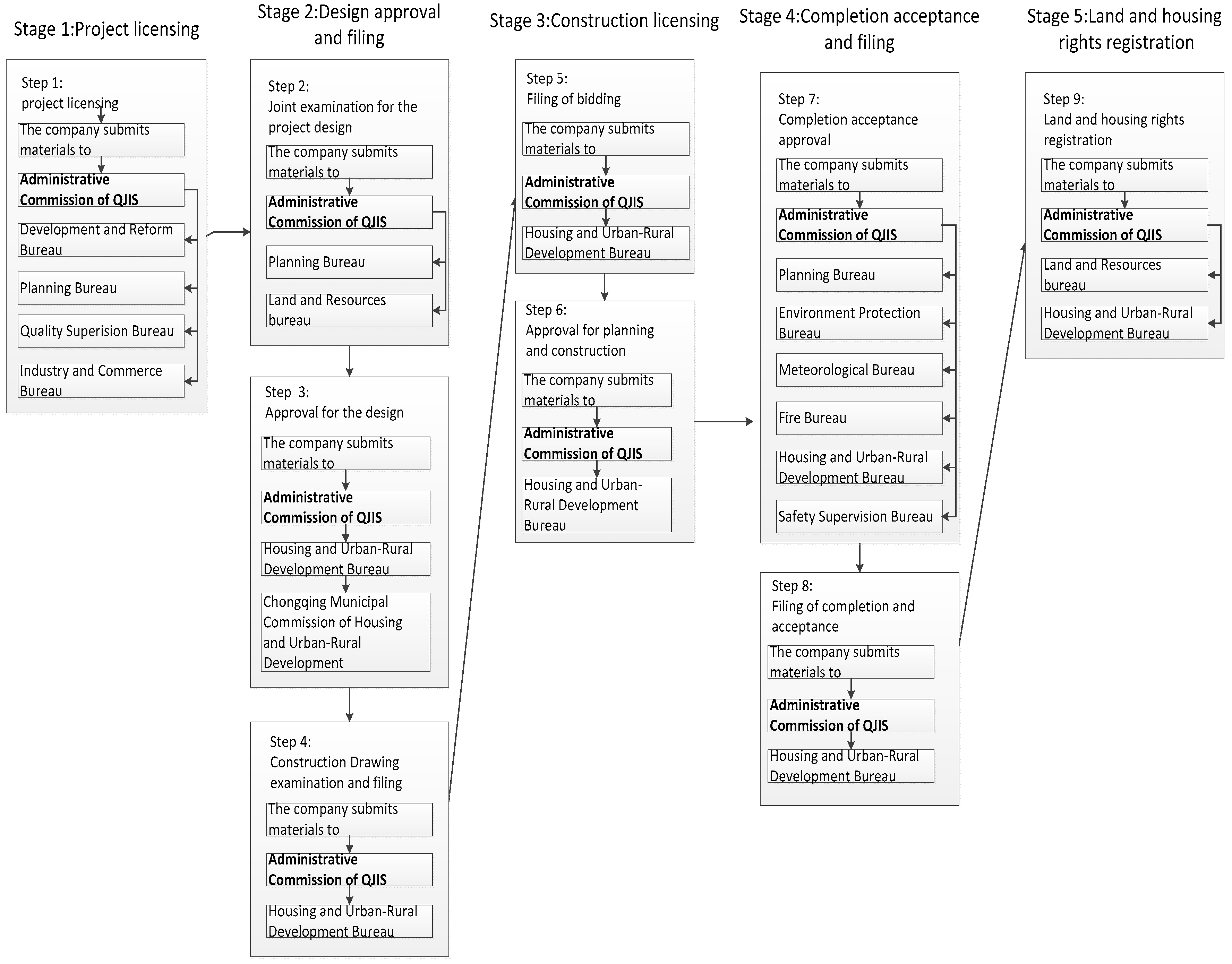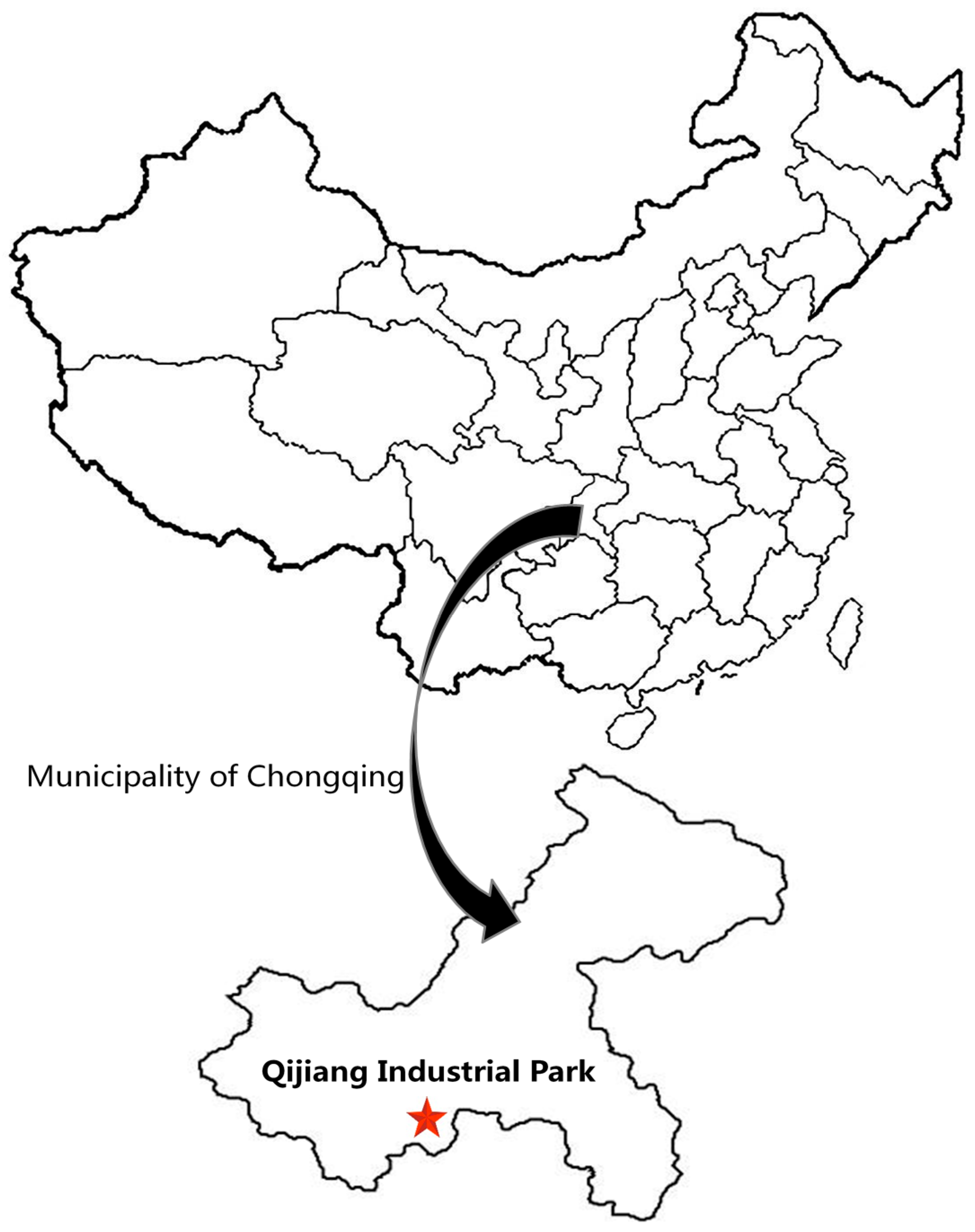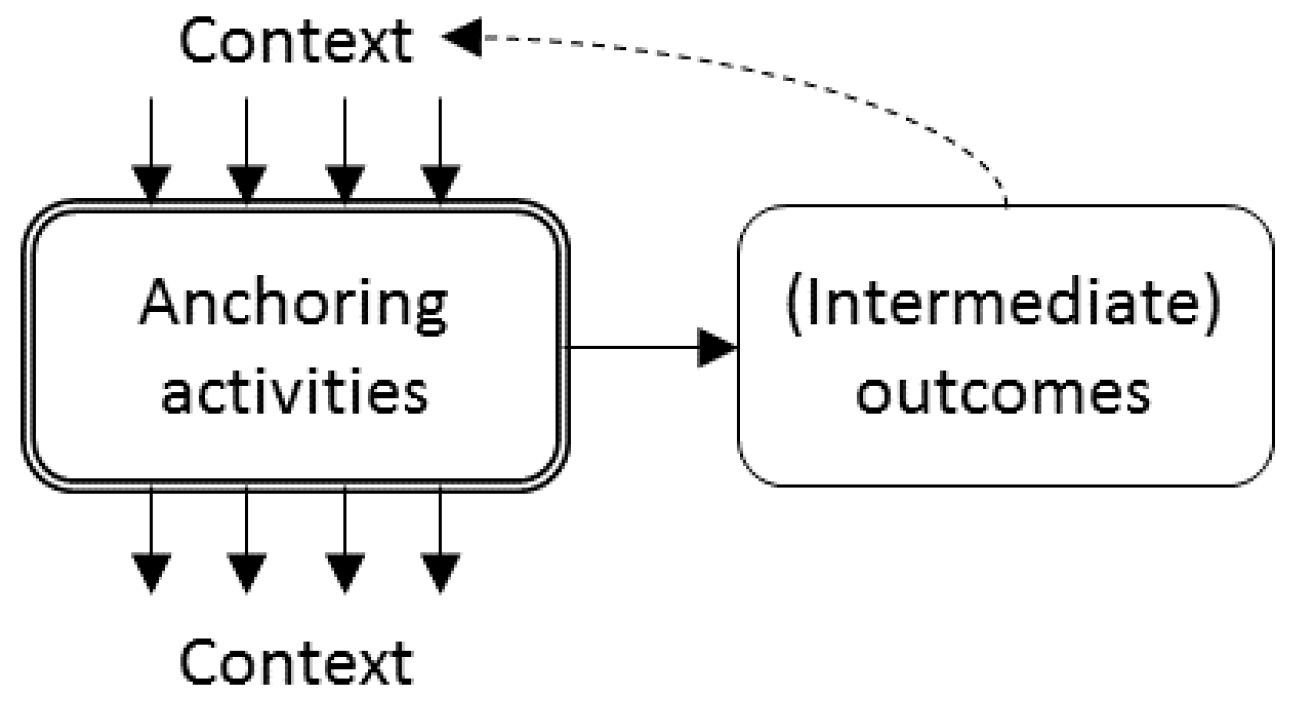Coordination of Industrial Symbiosis through Anchoring
Abstract
:1. Introduction
2. Methods
2.1. Literature Review
- (1)
- Actors: The types of organizations that are identified as anchors.
- (2)
- Activities: The activities that anchors are said to perform.
2.2. Selection of Case Study and Data Collection
2.3. Analysis
3. Case: Qijiang Industrial Symbiosis Park
3.1. Background
3.2. Qijiang Industrial Symbiosis
4. Conceptual Framework: Anchors and Anchoring in Industrial Symbiosis
“Anchor tenants do not have to be physical anchor tenants [...]. They may also take the form of institutional anchor tenants which aim to provide systems with information, social and economic infrastructure, decision making forums and institutional and political support. This could be handled by the municipality, or another actor, for the promotion of better environmental performance through industrial symbiosis and synergies between industries thus adding further industries and economic welfare and an environmental image for the community”.[8] (p. 1749)
5. Anchoring in the Qijiang Case
5.1. Preparation Phase of QJIS
5.2. Development Phase of QJIS
5.3. Operation Phase of QJIS
6. The Coordination of Anchoring Activities
7. Conclusions and Discussion
Acknowledgments
Author Contributions
Conflicts of Interest
Appendix A. Details of Literature Studying
Appendix B. Overview of Anchoring Activities and Publications in Which These Are Observed
| Activity | Type | References |
|---|---|---|
| Create opportunities for by-product and utility synergies | P | Lowe 1997; Chertow 2000; Korhonen 2002; Heeres, Vermeulen & De Walle 2004; Fichtner et al., 2005; Gibbs and Deutz 2005; Bansal and McKnight 2009; Liwarska-Bizukojc et al., 2009; Costa and Ferrão 2010a; Costa and Ferrão 2010; Chertow and Miyata 2011; Martin and Eklund 2011; Zhu and Ruth 2014; Gregson et al., 2015; Mannino et al., 2015 Lowe 1997; Lambert and Boons 2002; Eilering and Vermeulen 2004; Heeres, Vermeulen and De Walle 2004; Zhu and Ruth 2014; Park et al., 2008; Liwarska-Bizukojc et al., 2009; Costa and Ferrão 2010a; Lehtoranta et al., 2011; Martin and Eklund 2011; Yu, De Jong and Dijkema 2014; Mannino et al., 2015 |
| Provide (share) utilities and services | P | Korhonen 2002; Eilering and Vermeulen 2004; Von Malmborg 2004; Bansal and McKnight 2009; Liwarska-Bizukojc et al., 2009; Costa and Ferrão 2010a; Martin and Eklund 2011 |
| Provide physical infrastructures | P | Von Malmborg 2004; Liwarska-Bizukojc et al., 2009; Costa and Ferrão 2010a; Martin and Eklund 2011 |
| Facilitate interaction between stakeholders | I | Heeres, Vermeulen and de Walle 2004; Von Malmborg 2004; Wolf, Eklund and Söderström 2007; Bansal and McKnight 2009; Liwarska-Bizukojc et al., 2009; Costa and Ferrão 2010a; Martin and Eklund 2011; Boons and Spekkink 2012; Veleva et al., 2015 |
| Provide knowledge and expertise | I | Heeres, Vermeulen and de Walle 2004; Von Malmborg 2004; Liwarska-Bizukojc et al., 2009; Martin and Eklund 2011; Veleva et al., 2015 |
| Maintain close contact with relevant stakeholders | I | Von Malmborg 2004; Liwarska-Bizukojc et al., 2009; Costa and Ferrão 2010a; Pakarinen et al., 2010; Lehtoranta et al., 2011 |
| Provide platforms for education | I | Heeres, Vermeulen and de Walle 2004; Von Malmborg 2004; Boons and Spekkink 2012; Veleva et al., 2015 |
| Implement supporting laws and regulations | I | Von Malmborg 2004; Martin and Eklund 2011; Boons and Spekkink 2012 |
| Make inventories and databases of inputs and outputs | I | Lowe 1997; Van Leeuwen, Vermeulen and Glasbergen 2003 |
| Provide political support | I | Martin and Eklund 2011; Veleva et al., 2015 |
| Set beneficial prices | I | Liwarska-Bizukojc et al., 2009; Eilering and Vermeulen 2004 |
| Promote the area | I | Martin and Eklund 2011 |
| Recruit other companies for establishment | I | Lowe 1997; Van Leeuwen, Vermeulen and Glasbergen 2003 |
| Act as owner of industrial symbiosis projects | I | Baas 2011 |
| Provide managerial support | I | Veleva et al., 2015 |
| Be a role model | I | Von Malmborg 2004 |
Appendix C. Papers Included in the Review
Appendix D. Company’s Settlement Procedures to Qijiang Industrial Symbiosis

References
- Boons, F.; Chertow, M.; Park, J.; Spekkink, W.; Shi, H. Industrial Symbiosis Dynamics and the Problem of Equivalence: Proposal for a Comparative Framework. J. Ind. Ecol. 2016. [Google Scholar] [CrossRef]
- Boons, F.A.A.; Spekkink, W.A.H. Levels of Institutional Capacity and Actor Expectations about Industrial Symbiosis. J. Ind. Ecol. 2012, 16, 61–69. [Google Scholar] [CrossRef]
- Porter, M.E. Location, competition, and economic development: Local clusters in a global economy. Econ. Dev. Q. 2000, 14, 15–34. [Google Scholar] [CrossRef]
- Gordon, I.R.; McCann, P. Industrial Clusters: Complexes, Agglomeration and/or Social Networks? Urban Stud. 2000, 37, 513–532. [Google Scholar]
- Rescher, N. Process Metaphysics: An Introduction to Process Philosophy; State University of New York Press: New York, NY, USA, 1996. [Google Scholar]
- Burström, F.; Korhonen, J. Municipalities and industrial ecology: Reconsidering municipal environmental management. Sustain. Dev. 2001, 9, 36–46. [Google Scholar] [CrossRef]
- Von Malmborg, F. Networking for Knowledge Transfer: Towards an Understanding of Local Authority Roles in Regional Industrial Ecosystem Management. Bus. Strategy Environ. 2004, 13, 334–346. [Google Scholar] [CrossRef]
- Martin, M.; Eklund, M. Improving the environmental performance of biofuels with industrial symbiosis. Biomass Bioenergy 2011, 35, 1747–1755. [Google Scholar] [CrossRef]
- Chertow, M.; Park, J.Y. Scholarship and practice in industrial symbiosis: 1989–2014. In Taking Stock of Industrial Ecology; Clift, R., Druckman, A., Eds.; Springer International AG: Cham, Switzerland, 2016. [Google Scholar]
- Inkpen, A.C.; Pien, W. An examination of collaboration and knowledge transfer: China–Singapore Suzhou Industrial Park. J. Manag. Stud. 2006, 43, 779–811. [Google Scholar] [CrossRef]
- Wei, Y.H.; Lu, Y.; Chen, W. Globalizing regional development in Sunan, China: Does Suzhou Industrial Park fit a neo-Marshallian district model? Reg. Stud. 2009, 43, 409–427. [Google Scholar]
- Shi, H.; Chertow, M.; Song, Y. Developing country experience with eco-industrial parks: A case study of the Tianjin Economic-Technological Development Area in China. J. Clean. Prod. 2010, 18, 191–199. [Google Scholar] [CrossRef]
- Yu, C.; de Jong, M.; Dijkema, G.P.J. Process analysis of eco-industrial park development—The case of Tianjin, China. J. Clean. Prod. 2014, 64, 464–477. [Google Scholar] [CrossRef]
- Yu, F.; Han, F.; Cui, Z. Evolution of industrial symbiosis in an eco-industrial park in China. J. Clean. Prod. 2015, 87, 339–347. [Google Scholar] [CrossRef]
- Shi, H.; Tian, J.; Chen, L. China’s Quest for Eco-industrial Parks, Part I. J. Ind. Ecol. 2012, 16, 8. [Google Scholar] [CrossRef]
- Abell, P. The Syntax of Social Life: The Theory and Method of Comparative Narratives; Clarendon: Oxford, UK, 1987. [Google Scholar]
- Abell, P. Some aspects of narrative method. J. Math. Sociol. 1993, 18, 93–134. [Google Scholar] [CrossRef]
- Shi, L.; Wang, Z. Eco-industrial Parks in China (2000–2010). J. China Univ. Geosci. (Soc. Sci. Ed.) 2010, 10, 60–65. [Google Scholar]
- Jiao, W.T.; Boons, F. Toward a research agenda for policy intervention and facilitation to enhance industrial symbiosis based on a comprehensive literature review. J. Clean. Prod. 2014, 67, 14–25. [Google Scholar] [CrossRef]
- Chertow, M.R. Industrial Symbiosis: Literature and Taxonomy. Annu. Rev. Energy Environ. 2000, 25, 313–337. [Google Scholar] [CrossRef]
- Lowe, E.A. Creating by-product resource exchanges: Strategies for eco-industrial parks. J. Clean. Prod. 1997, 5, 57–65. [Google Scholar] [CrossRef]
- Mirata, M. Experiences from early stages of a national industrial symbiosis programme in the UK: Determinants and coordination challenges. J. Clean. Prod. 2004, 12, 967–983. [Google Scholar] [CrossRef]
- Hewes, A.K.; Lyons, D.I. The Humanistic Side of Eco-Industrial Parks: Champions and the Role of Trust. Reg. Stud. 2008, 42, 1329–1342. [Google Scholar] [CrossRef]
- Paquin, R.L.; Howard-Grenville, J. The Evolution of Facilitated Industrial Symbiosis. J. Ind. Ecol. 2012, 16, 83–93. [Google Scholar] [CrossRef]
- Paquin, R.L.; Howard-Grenville, J. Blind Dates and Arranged Marriages: Longitudinal Processes of Network Orchestration. Organ. Stud. 2013, 34, 1623–1653. [Google Scholar] [CrossRef]
- World Bank. Urban China: Toward Efficient, Inclusive, and Sustainable Urbanization. 2014. Available online: https://openknowledge.worldbank.org/handle/10986/18865 (accessed on 2 August 2016).
- Yu, C.; Dijkema, G.P.; Jong, M. What Makes Eco-Transformation of Industrial Parks Take Off in China? J. Ind. Ecol. 2015, 19, 441–456. [Google Scholar] [CrossRef]
- Schatzki, T. Keeping track of large phenomena. Geogr. Z. 2016, 104, 4–24. [Google Scholar]
- Boons, F.A.A. Self-organization and sustainability: The emergence of a regional industrial ecology. Emerg. Complex. Organ. 2008, 10, 41–48. [Google Scholar]
- Zhu, J.; Ruth, M. The development of regional collaboration for resource efficiency: A network perspective on industrial symbiosis. Comput. Environ. Urban Syst. 2014, 44, 37–46. [Google Scholar] [CrossRef]



| Private Organizations | Public Organizations | ||
|---|---|---|---|
| Organization type | Count | Organization type | Count |
| Power plant | 17 | Public authority | 6 |
| Combined heat and power plant | 5 | Public Utilities | 1 |
| Pulp and paper mill | 3 | ||
| Chemical plant | 3 | ||
| Business association | 3 | ||
| Food processing facility | 2 | ||
| Wallboard manufacturer | 1 | ||
| Pharmaceutical plant | 1 | ||
| Oil Refinery | 1 | ||
| Electronic equipment plant | 1 | ||
| Resource recovery plant | 1 | ||
| Brewery | 1 | ||
| Waste transfer station | 1 | ||
| Waste incinerator | 1 | ||
| Physical Anchoring | Institutional Anchoring |
|---|---|
Contributing to synergies:
| Stimulating social interactions:
|
Creating infrastructure
| Knowledge support:
|
Political and managerial support:
| |
Recruitment:
| |
Spearheading projects:
|
| Rural Land | Urban Land | |
|---|---|---|
| Ownership | Owned by rural collective | State owned, represented by municipal government |
| Permissible Use | Agriculture, villager’s homestead, village public facilities, and village enterprises | Industrial, commercial, residential, administrative, urban public facilities, urban infrastructure, etc. |
| Land Use Rights | Permanent with the village and (in case of homestead) villagers, leasing out permitted | Provided through public land leasing, with a period of 70 years for residential land, 50 years for commercial land, and 40 years for industrial land |
| Central Government | Chongqing Municipality | Qijiang District | |
|---|---|---|---|
| Corporate Income Tax | 60% | N/A | 40% 1 |
| Added Value Tax | 75% | N/A | 25% 2 |
| Business Tax | N/A | 40% | 60% 2 |
| Individual Income Tax | 60% | 16% | 24% |
| Others | N/A | N/A | 100% |
| Phase | Id | Order | Activity | Actor(s) | Anchoring |
|---|---|---|---|---|---|
| Preparation Phase | a1 | t1 | Providing institutional setting | -National government | Institutional |
| -Municipal government | |||||
| a2 | t2 | Expropriating land | -Qijiang government | Physical | |
| a3 | t3 | Providing physical infrastructure | -Qijiang government | Physical | |
| -Administrative Commission | |||||
| Development Phase | a4 | t4 | Implementing preferential policies | -Qijiang government | Institutional |
| a5 | t5 | Recruiting companies | -Administrative Commission | Institutional | |
| a6 | t6 | Facilitating companies’ settlement | -Administrative Commission | Institutional | |
| Operation Phase | a7 | t7 | Providing by-product and utility synergies | -Qineng anchor company | Physical |
| a8 | t7 | Providing Managerial Support | -Administrative Commission | Institutional | |
| a9 | t7 | Seeking funding | -Administrative Commission | Institutional | |
| a10 | t7 | Promoting R&D | -Administrative Commission | Institutional |
© 2017 by the authors. Licensee MDPI, Basel, Switzerland. This article is an open access article distributed under the terms and conditions of the Creative Commons Attribution (CC BY) license (http://creativecommons.org/licenses/by/4.0/).
Share and Cite
Sun, L.; Spekkink, W.; Cuppen, E.; Korevaar, G. Coordination of Industrial Symbiosis through Anchoring. Sustainability 2017, 9, 549. https://doi.org/10.3390/su9040549
Sun L, Spekkink W, Cuppen E, Korevaar G. Coordination of Industrial Symbiosis through Anchoring. Sustainability. 2017; 9(4):549. https://doi.org/10.3390/su9040549
Chicago/Turabian StyleSun, Li, Wouter Spekkink, Eefje Cuppen, and Gijsbert Korevaar. 2017. "Coordination of Industrial Symbiosis through Anchoring" Sustainability 9, no. 4: 549. https://doi.org/10.3390/su9040549





